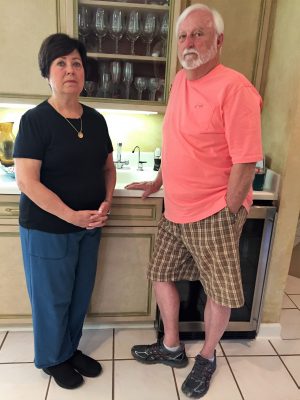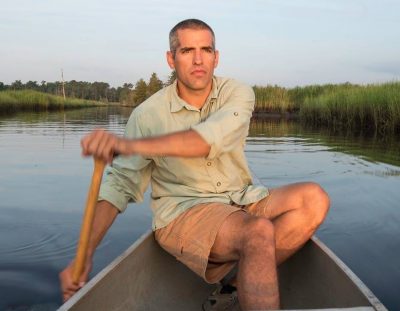Last of a series
WILMINGTON – Kemp Burdette gestured behind him to one of the newest additions in his office, which sits just a few dozen yards from the Cape Fear River and close enough to its eponymous Memorial Bridge that the low thrum of truck traffic trundling overhead often accompanies conversation.
Supporter Spotlight
Among his other duties as riverkeeper at Cape Fear River Watch, Burdette offers suggestions to people looking to reduce their impacts on the environment, and he strives to serve as an example.
“We used to tell people to drink tap water,” he said. “That was one of our top five things you can do to help the environment, to drink tap water, because we have a really good water treatment plant in Wilmington. It’s one of the best in the state, probably among the top 10 percent in the country.”
That was before last summer, when news broke that GenX and other substances from the Chemours plant about 100 miles upriver had contaminated the Cape Fear and drinking water sourced from it by the Cape Fear Public Utility Authority, whose state-of-the-art filtration technology proved unable to remove the fluorochemicals.
Ongoing state and federal investigations revealed the chemicals have been discharged to the river since at least 1980. Regulators subsequently found similar substances from Chemours, such as byproducts of its Nafion production, also have polluted the river and that the company’s air emissions contributed to the tainting of hundreds of private wells around the plant.
During an interview late last month, Burdette cocked his head toward a water dispenser in a corner of a conference room. “I installed this water tank here. I’m in this position now that I can’t tell people to drink the tap water. We know GenX is there at levels below the state’s health standard, but all this Nafion stuff is in there at levels a bit higher. I’m not comfortable drinking tap water. I occasionally drink it, but my water intake from taps has gone way down. I think people in Wilmington are drinking a lot less tap water.”
Supporter Spotlight
‘Partisanship Is Still a Helluva Drug’
Many residents affected by the contamination have taken similar personal steps, installing home water-filtration systems or buying bottled water.

Some have done more. Ad hoc groups coalesced around the issue. Mary Alice and Skip Hinshaw are among about 340 New Hanover County residents enrolled in the first research effort on GenX and similar substances in humans. Mike Watters of Cumberland County has taken on a citizen-scientist role, working with researchers to study the potential uptake of GenX in his homegrown vegetables.
But has water quality become an issue with enough priority to affect how people may cast their votes and what they expect of the state’s elected leaders in terms of protecting their drinking water?
Aaron King, a professor in the Department of Public and International Affairs at the University of North Carolina Wilmington, said he and his wife started buying bottled water at the local Costco after last summer.
“I have a newborn at home and toddler,” King said. “When everything first broke, a lot of people were really concerned. To the extent somebody was going to take action, we’ve seen that. Some people would attend meetings. Some would get reverse-osmosis systems for their homes or buy bottled water. If all this went down in August of this year, it would be a different situation. But once people have adjusted to what they feel like is safe for them and their family, I just wonder how much staying power this issue will have.
“If you went on the street and asked people if they care about GenX, people will say they care about it,” he said. “But that’s a whole different story than caring about it enough to vote or to vote for someone you might not otherwise have voted for. If you are a Republican, I don’t know that this is the issue where people are going to say, ‘Oh, I’m going to support a Democrat now.’ Partisanship is still a helluva drug.”
‘People Who Are Passionate Can Move the Needle’
A few weeks ago at Cape Fear River Assembly’s 45th annual meeting in Wilmington, GenX dominated discussion. Among those presenting was Detlef Knappe, a professor at N.C. State University and a member of the team of scientists who found Chemours’ fluorochemicals in the water.
“I put a bunch of chemical names on a slide, and I said, ‘Which of these has gotten the most attention?’ Well, of course GenX. I said, ‘Here’s all this other stuff that’s out there, some of it in higher concentrations and of similar health concern.’
“I think the percentage of the people who embrace the larger issue is pretty small. I think if you were to survey the people in Wilmington about 1,4-dioxane or bromide or perfluoro-2-methoxyacetic acid (PFMOAA), I don’t know how many people would really immediately say, ‘I’m as concerned about those as I am about GenX.’”
Like GenX, the chemicals Knappe mentioned are considered to be emerging contaminants, a growing list of unregulated substances ranging from pharmaceuticals and personal-care products to pesticides and endocrine-disrupting compounds that have turned up in drinking water in the United States and worldwide.
“I think if you were to survey the people in Wilmington about 1,4-dioxane or bromide or perfluoro-2-methoxyacetic acid, I don’t know how many people would really immediately say, ‘I’m as concerned about those as I am about GenX.’”
Detlef Knappe, Professor of civil, construction, and environmental engineering, N.C. State University
“I’m amazed at the energy that some people have put into this and the amount of research they’re doing,” Knappe said. “Certainly, there is a good segment of the population that has devoted a lot of time and energy to that. They have become very well-educated on the topic, mostly through their own research and reading. That’s probably a minority. I think there’s a large number of people who have heard about GenX and are worried about GenX, but they may not be as aware of the other contaminants that are in the water.”
Burdette said he believes the experiences of the last year eroded the largely unchallenged and widespread assumption that water people drink is safe.
“I do think the public has realized around here that there’s not this elaborate, well-funded system out there that is designed to look at drinking water supplies, protect them, do checks on them, monitor them on a regular basis. Before all of this, I and other people just kind of imagined that our water was going to be protected, because, you know, you have to have water, so you think it’s going to be clean. We have a Department of Environmental Quality that’s probably doing all kinds of things to protect our water supply.
“Now, I think what people realize that’s not the case, that water is not a resource that’s particularly well protected. It’s treated, and there’s a fair amount of effort that goes into water treatment, but we’re treating for the same things we were treating for 100 years ago. We’re trying to get out bacteria and get out things that affect taste and odor, but we’re way behind on treating for the kinds of things that are being produced now, really complicated molecules that stick around for a long time and interact with other stuff.”
Typically, midterm elections such as November’s draw far fewer voters than those that include presidential races. That factor, Burdette said, may amplify the impact of water quality on the outcome of some contests.
“It’s that rule, that not many people are voting,” Burdette said. “The people who are passionate about things can move the needle. When whatever pollsters do their work, I suspect GenX and water quality and water issues will be factors.
“I don’t know if it would change the mind of somebody who votes Republican to vote Democrat. It might convince somebody who was pretty ambivalent about politics to vote, to start to make the connection and demand that their elected officials take the actions they think are needed to address this problem.”










